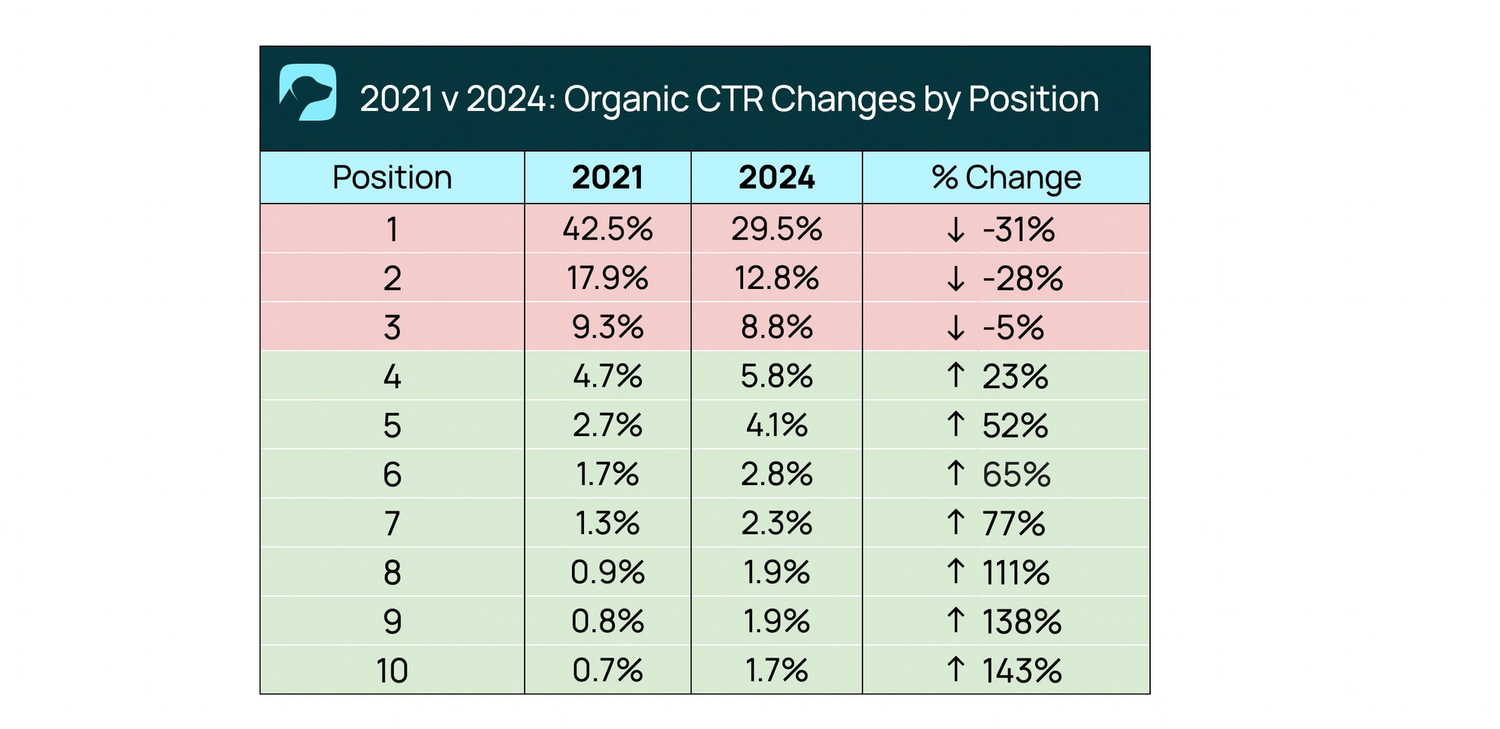Organic CTR: Insights from 13 million keywords
At Indago, we’ve been collecting Australian organic (SEO), click and Click-Through Rate (CTR) data on over 13 million keywords since 2020. Every year, we report our findings to help you understand what you should expect from your SEO efforts and rankings.
For this year’s analysis, we’ve focused on three main areas:
- Organic CTR benchmarks for first-page search results
- YoY changes to organic CTR by position
- Reasons for the drop in organic traffic
The longevity of SEO
We've seen time and time again how a well-executed SEO strategy can transform a client’s online presence, driving organic traffic, boosting brand visibility, and ultimately increasing their conversions.
In fact, we now know that around 70% of our clients’ search traffic comes from their SEO efforts.

While investing in SEO can certainly help you appear in Search Engine Result Pages (SERPs) – this visibility is meaningless if no one actually clicks through to your site.
For this reason, understanding the relationship between Click-Through Rates (CTR) and where you sit in SERPs is crucial.
What is a good CTR benchmark for organic search?
Unsurprisingly, our data shows that CTR (and therefore traffic) drops exponentially as you move down the first page of Google.
As such, we've only focused on first-page search results, as traffic beyond these typically does little for you [insert awful SEO joke about where to hide a dead body].

We found that search results in positions 1-3 account for just over half (51.1%) of all click-through rates.
The benchmark CTR for a page ranking in position 1 is 29.5% and those in positions 2 and 3 can expect an average CTR of 12.8% and 8.8%, respectively.
Keep in mind, these averages do not account for rich results like images and videos.
YoY results: Comparing CTR for top search engine positions
While the power of positions 1-3 is undeniable, they aren’t as powerful as they used to be.
Our data shows that SEO traffic for position 1 has dropped by a whopping 31% over the past four years.

This means if your page is ranking in position 1, it'll still receive the highest CTR at an average of 29.5%; however, back in 2021, you could expect a CTR of around 42.5%.
Similarly, pages in position 2 today will receive approximately 28% less organic traffic than they did in 2021 and position 3 results now have an organic CTR benchmark of just 8.8%.

The biggest drop in organic CTR for the three top search engine positions occurred during 2022-2023, and this year’s data proves that it wasn’t just an anomaly.
With generative search features like Google AI overview, this continual drop in organic traffic will only increase and the need for SEOers to adapt becomes even more paramount.
What is causing low organic CTR?
There are many influences that need to be considered, but here are the three most likely reasons top search engine positions are experiencing a decrease in CTR.
1. The evolution of SERPs
One common cause of low click-through rates is changes to the layout of SERPs.
From their decision to drop the continuous scroll feature to the introduction of AI Overviews, Google frequently updates the way its search results work to deliver a more user-friendly experience.
The biggest example is increasingly popular search features that keep users on the results page and reduce their need to click.

Think about how many times you’ve ended your search after seeing the following:
- People Also Asked – Can provide immediate answers to multiple questions.
- Maps – Offers opening hours, location, reviews and phone numbers at a glance.
- Knowledge Graph – Often sits in the top right hand of the search results and delivers factual information on your search.
While these features make searching easier for users, it discourages them from visiting your site, leaving you with lower CTRs (and therefore lower conversation rates).
2. Voice search and virtual assistants
Whether you’re using Alexa or Siri — Voicebot.ai’s report affirms virtual assistants are on the rise and reshaping the way we search.
Their ability to provide direct, auditory answers can decrease user interaction with traditional search results, and yep, reduce clicks.
3. Evolving user behaviour
Consumers today are undoubtedly more proficient at searching online. A study from The Nielsen Norman Group found that users have become more skilled at scanning SERPs.
They want to click on results that quickly address their search, which would lead to decreased CTRs as they make better decisions and click through to fewer websites.

How do we adapt?
With the arrival of AI in search, we’ll continue to see this drop in CTR, and as an industry, we need to redefine our approach to SEO.
1. Targeting zero-click traffic
If you can’t beat em’, join em’.
Because of their popularity, it’s safe to assume these no-click features are only going to increase and so we need to produce content in formats that allow us to control these results.
Let’s be the brand people see straight away and deem the authority in our respective spaces.
2. Leveraging different SEO monitoring tools
While we’re not at the point where we can’t measure SEO’s effectiveness by using traffic and conversions, we need to branch out by placing more value on impressions and the branding element SEO provides.
Consider how often potential customers conduct a ‘brand’ search to validate using you. It's no longer just about ranking high on search engines; it's about staying relevant and accessible to your audience through positive reviews, PR initiatives or a Wiki page. The value here is huge.
Is there a difference in answering a potential customer’s questions within Google or on your website?
While users visiting your site allow for cookie tracking and data capture, the brand value of being the go-to answer on Google is surely comparable. We need to both measure that result and assign a value to it.
Conclusion
The landscape of SEO is changing, and while the drop in CTRs for organic search engine rankings presents a challenge, it also offers an opportunity for innovation.
By understanding these trends and adapting our strategies, we can continue to drive value from our SEO efforts. At Indago, we’re committed to staying ahead of the curve and helping our clients navigate these changes.
Wondering how you can get more organic search traffic? Book a quick chat with us today, and let's maximise your digital presence together.
Written by
Gary Nissim





